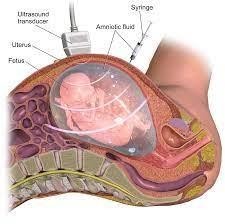A nurse is reinforcing teaching with a client who is at 15 weeks of gestation and is about to undergo an amniocentesis. The nurse should reinforce that this test can identify which of the following traits or problems? (Select all that apply.)
Cephalopelvic disproportion
Neural tube defects
Rh incompatibility
Fetal gender
Chromosome defects
Correct Answer : B,C,D,E
Choice A rationale: Cephalopelvic disproportion is a condition where the baby's head is too large or the mother's pelvis is too small for a vaginal delivery. Amniocentesis does not provide information about this condition.
Choice B rationale: Amniocentesis can be used to detect neural tube defects such as spina bifida and anencephaly.
Choice C rationale: Rh incompatibility occurs when the mother is Rh-negative, and the fetus is Rh-positive. This can lead to hemolytic disease of the newborn (HDN) if untreated. While Rh incompatibility can be detected through blood tests (maternal blood), amniocentesis is typically not used to diagnose this condition.
Choice D rationale: Amniocentesis can be used to determine the fetal gender by analyzing the DNA in the amniotic fluid. This is not the primary purpose of amniocentesis, but it can certainly identify the gender, especially in cases where this information is needed for medical reasons, such as gender-linked genetic disorders.
Choice E rationale: Amniocentesis is commonly used to screen for chromosomal abnormalities such as Down syndrome (trisomy 21) and other genetic conditions.

Nursing Test Bank
Naxlex Comprehensive Predictor Exams
Related Questions
Correct Answer is B
Explanation
Choice A rationale:
Administering the hepatitis B vaccine monthly until the newborn tests negative for the hepatitis B surface antigen is not the appropriate treatment for a newborn whose mother is positive for the hepatitis B surface antigen. Immediate intervention is required to prevent transmission.
Choice B rationale:
The newborn of a mother who is positive for the hepatitis B surface antigen should receive hepatitis B immune globulin (HBIG) and the hepatitis B vaccine within 12 hours of birth. HBIG provides passive immunity to the baby while the vaccine stimulates active immunity.
Choice C rationale:
Administering hepatitis B immune globulin for 1 week followed by the hepatitis B vaccine monthly for 6 months is not the correct treatment plan. Immediate intervention is necessary to prevent transmission to the newborn.
Choice D rationale:
Administering the hepatitis B vaccine at 24 hours followed by hepatitis B immune globulin every 12 hours for 3 days is not the appropriate treatment. Hepatitis B immune globulin should be given within 12 hours of birth, not over several days.
Correct Answer is D
Explanation
A. Breast engorgement typically occurs around days 3 to 5 postpartum, so encouraging frequent nursing at 14 hours postpartum will not impact milk production at this stage.
B. A temperature of 37.7°C (100°F) is a normal postpartum finding due to dehydration and hormonal changes. It does not require reporting unless it exceeds 38°C (100.4°F).
C. Increasing IV fluids is not necessary unless there is evidence of dehydration or another medical indication.
D. A slightly deviated fundus suggests bladder distension, which can interfere with uterine involution. Asking the client to empty her bladder helps the uterus contract properly and prevents complications such as postpartum hemorrhage.
Whether you are a student looking to ace your exams or a practicing nurse seeking to enhance your expertise , our nursing education contents will empower you with the confidence and competence to make a difference in the lives of patients and become a respected leader in the healthcare field.
Visit Naxlex, invest in your future and unlock endless possibilities with our unparalleled nursing education contents today
Report Wrong Answer on the Current Question
Do you disagree with the answer? If yes, what is your expected answer? Explain.
Kindly be descriptive with the issue you are facing.
